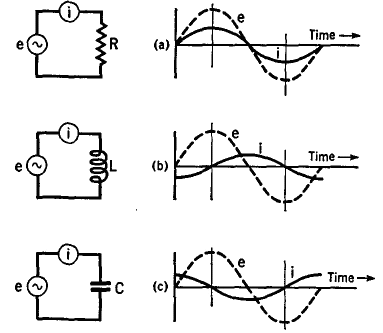| Basic Radio is a free introductory textbook on electronics based on tubes. See the editorial for more information.... |

|

Home  Fundamentals Fundamentals  Alternating Currents Alternating Currents  Phase Phase |
||||||||
| See also: Reactance and Impedance | ||||||||






|
||||||||
|
PhaseAuthor: J.B. Hoag If an a.c. generator is connected to a pure resistance, the voltage and current through the resistance will be "in phase" with each other. This means that they both reach their positive maximum values at the same instant. Similarly they have their zero value and their negative maximum value at the same instant. See a in Fig. 4 E. If an a.c. generator is connected to a pure inductance,1 the electrical "inertia" of the inductance causes the current to lag behind the impressed e.m.f. by 90°, or one-quarter of a period. This is shown in b of Fig. 4 E.
In a series circuit of inductance and capacitance, the current will lag behind the impressed e.m.f. somewhere between 0° and 90° if the inductive effect is greater, and will lead somewhere between 0° and 90° if the capacitative effect is predominant.
|
||||||||
Home  Fundamentals Fundamentals  Alternating Currents Alternating Currents  Phase Phase |
||||||||
Last Update: 2010-11-21


